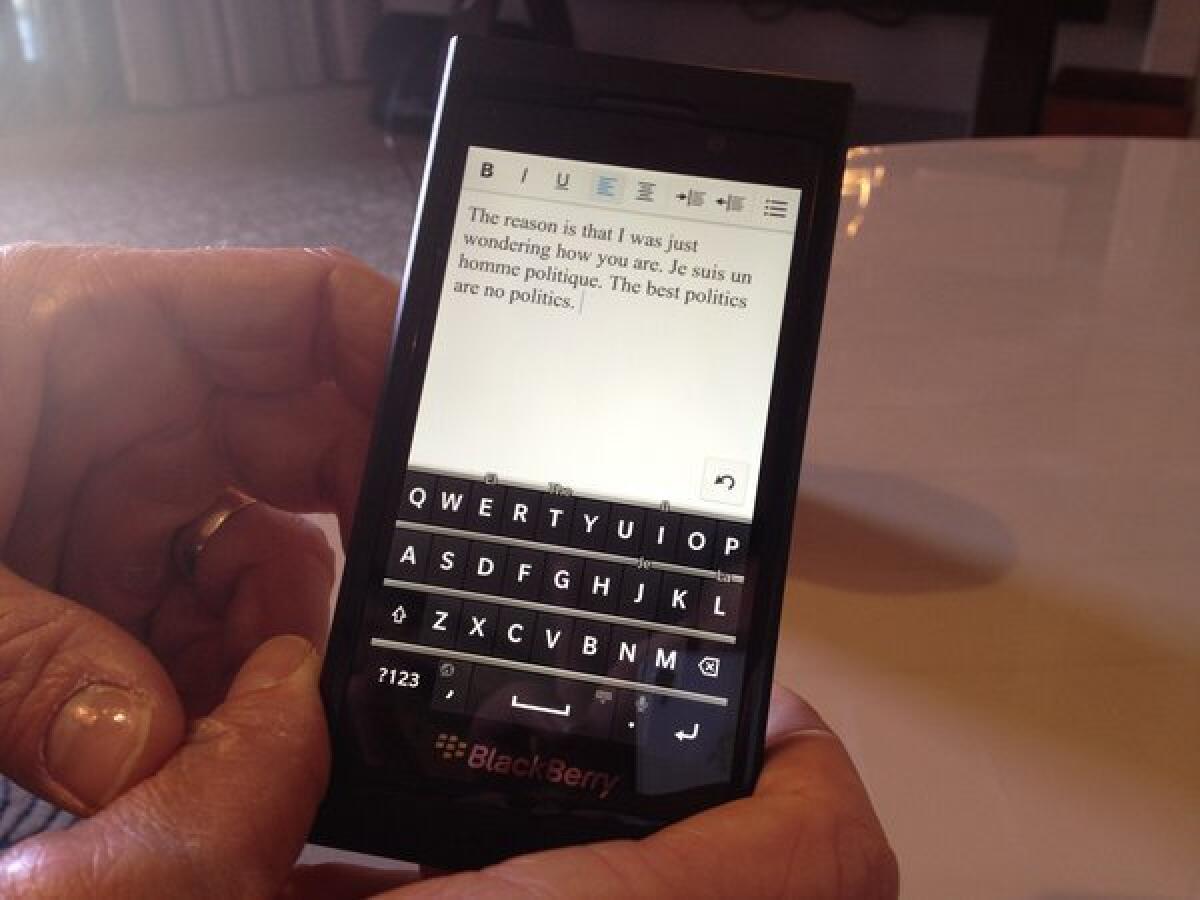Hands-on demo with new BlackBerry 10 touchscreen phone at CES 2013

LAS VEGAS -- BlackBerry 10 finally debuts at the end of the month, and we got a private demo at CES of one of the two smartphones that will run the long-delayed operating system.
Richard Piasentin, Research in Motion’s U.S. managing director, walked me through a lengthy preview of the touchscreen-only device, which was cloaked in a plastic bumper to mask its full appearance (you’ve got to leave something to the imagination for the big Jan. 30 launch event, right?).
Originally supposed to be released in late 2011, BlackBerry 10 has been called a make-or-break product for the floundering Canadian smartphone maker as it tries to regain lost share in the U.S. and other crucial markets. Even if BlackBerry 10 is technically strong, some analysts have said the operating system is just too late to the game and faces a tough uphill battle against the widely popular iPhone and Android-operated smartphones.
It’s a challenge not lost on Piasentin, who said despite his confidence that BlackBerry 10 was a stellar product, RIM was “rational.”
“We’re very aware of our market, very aware of our position,” he said from his suite at the Cosmopolitan hotel. “We have aggressive goals, but they’re reasonable goals. And before you can be No. 1 you’ve got to be No. 2, before you can be No. 2, you’ve got to be No. 3. And we’re building our plans for the long, slow climb back to the top.”
But back to the new BlackBerry phone. It was black all over, appeared to be very thin, had no home button and featured front- and rear-facing cameras. The phone takes HD video, has a screen resolution better than the iPhone 5, features a faster browser and, as I mentioned above, was missing that signature BlackBerry physical keyboard.
Among the new features is the BlackBerry Hub, where you can find your email, notifications and social media apps such as Facebook and Twitter. The BlackBerry Hub is always to the left of your on-screen image, so you can access it with a drag of the finger; Piasentin said one big perk is you don’t have to quit out of whatever you’re doing to access it, a time-saving feature that RIM is calling BlackBerry Flow.
With many people using their smartphones for work and play, RIM has incorporated dual profiles into the same phone, “personal” and “work.” That means different app grids based on which profile you’re in, so for instance if you’re not allowed to use Facebook on company time, the app won’t show up under your work profile but will under your personal one.
I was most interested to see the new touchscreen that is replacing BlackBerry’s excellent physical keyboard. Personally, that’s always the feature that keeps me reaching for my BlackBerry instead of my iPhone when I need to pound out a story or an email quickly and am not at my desk.
RIM has been touting the superiority of its touchscreen, and Piasentin said he believes “we’ll be able to convert some people” who are diehard physical keyboard fans. The new touchscreen keyboard features predictive text and is personalized, so if you’re like me and always accidentally type “U” when you meant to type “I,” the keyboard will learn that over time and adapt to your typing patterns, Piasentin said. The keyboard also recognizes words and phrases you often use and will predict those more frequently; select predictive text with an upward flick of the finger. A downward swipe brings up punctuation and other symbols.
You can delete words or phrases with a horizontal swipe of the finger instead of the cumbersome tap-tap-tap motion on other smartphones. Text effects such as bold, underline and italics appear automatically at the top of the screen and you can seamlessly type in several languages in the same email.
I tried out the keyboard function and it did appear to give me more accurate results than what I get on my iPhone. The predictive text was far from perfect but was handy to have.
You can swipe anywhere on the phone’s screen to unlock the device, and when it’s time for bed, just swipe your finger down from the top of the touchscreen to pull down a do-not-disturb “window shade.” Set your alarm by dragging your finger along the circumference of the image of a clock.
With so much riding on the success of BlackBerry 10, Piasentin said RIM is ready and pleased with the product after facing some “tough decisions” about when to release the OS.
“Clearly, it’s not lost on me -- especially as the guy running the U.S. -- it would have been great to release BB10 earlier,” he said. “But we had to take the position that this operating system needs to be flawless when we release it.”
And despite falling down the ladder in the U.S. smartphone game, Piasentin said with only about 53% smartphone penetration nationwide, there’s still ample opportunity to woo new customers.
Nonetheless, is this RIM’s last chance?
“I have no belief that that’s the case at all. We have a very specific strategy,” he said. “For us, there is no failure state. We’re not wondering. There’s no Plan B because we don’t think we need one.”
ALSO:
CES 2013: Helpful emergency gadgets for seniors
CES 2013: How tablets are changing desktop computers
At the Consumer Electronics Show, more glitz than gee whiz
More to Read
Inside the business of entertainment
The Wide Shot brings you news, analysis and insights on everything from streaming wars to production — and what it all means for the future.
You may occasionally receive promotional content from the Los Angeles Times.










